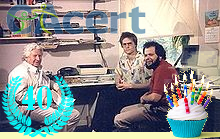
40 years ago, the Chaos Computer Club was founded in Germany. Steffen Wernéry (on the picture in the middle) was there from the beginning. That’s why he’s already been in prison. Interview.
You soon became the most important figure in the club next to Wau Holland and later wrote the statutes. It says that the club is committed to freedom of information. What does that mean, freedom of information?
Steffen Wernéry: It means the right to freely exchange information. In other words, to communicate in encrypted form, with anyone, about anything, without censorship, without blockades. I find the second part of the statutes particularly important: the CCC is concerned with the effects of technologies on society and individual living beings and promotes knowledge about these developments.
How did you want to achieve all this?
Steffen Wernéry: We organised congresses, meetings and events. We have a magazine, the “Datenschleuder”. Of course, it was also about fun and creativity. What we call in the statutes “promoting the creative-critical use of technology”. We had originally written “hack” in the statutes, but the association register rejected this word because it was not in the Duden dictionary.
It was a hack on the edge of the permissible that made the Chaos Computer Club famous.
Steffen Wernéry: That was in 1984, when the post office had a monopoly on electronic messages. And anyone who wanted to be online had to use a device approved by the post office, which was incredibly expensive. Anyone using untested equipment was liable to a house search and confiscation of the equipment, along with a fine. The user fees for this system, the Internet precursor screen text (BTX), were very high. So the post office, we called them “Gilb”, was the enemy of hate for us. At that time, Wau Holland and I hacked into the BTX access of a Hamburg savings bank and called up a BTX page of the CCC from there, for which we had to pay. By the end of the night, we had booked 135000 D-Mark into our fee account. We made that public. It was embarrassing for the post office, which had claimed that its system was secure. The media jumped on the story. For the first time, data security was a big topic.
What happened next with the CCC?
Steffen Wernéry: That was the beginning of an acceleration. We got new members, there were more and more people on the networks. In 1986, things became more serious. A few people in the club had hacked into Nasa’s computers and sold information to the Soviet secret service KGB. The main participant, Karl Koch, was later found dead. To this day, some say it was suicide, others say it was murder. I myself spent two months in a French prison.
Why?
Steffen Wernéry: At that time, there were hardly any computers on the net. We hackers went where there were networks, for example to the Swiss research centre Cern. That was the European hacker training school. Because there, several people could be on the computers at the same time, chatting online or developing programmes together. Because some of these centres were also used for military purposes, this was quite critical. That’s why there have been investigations since 1986.
How did the trial against you turn out?
Steffen Wernéry: There was never a trial, but the investigations against me lasted 16 years, until 1998, without any result. The Hamburg prosecutor spread the word that I was an East German agent because a picture of Honecker hung in my kitchen. For the French, I was a Nazi because they had found “Mein Kampf” during the same house search. There was also mistrust within the club because of these investigations. It all became too much for me and I quit the front row.
